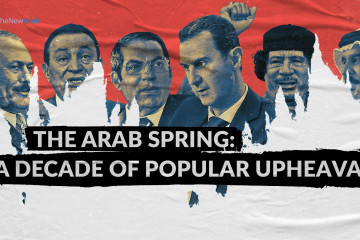

On 17 December 2010, a tragic event in the small Tunisian town of Sidi Bouzid ended up causing a political earthquake throughout the Middle East and North Africa. Mohamed Bouazizi, a street vendor, had had enough of being humiliated by unaccountable public officials demanding he give them bribes in order to continue his work. He set himself on fire outside the town hall. Less than three weeks later, he died of his injuries.
His cause was taken up by thousands of locals who demonstrated in front of the town hall and used mobile phones and social media to spread the news. The protests turned into a mass movement which spread across Tunisia and eventually forced Tunisian dictator Zine el-Abidine ben Ali to flee the country less than a month later.
Activists in Egypt, Syria, Libya, Yemen, and Bahrain, among other countries, were inspired to protest against their own governments. The flight of Ben Ali was soon followed by the resignation of President Hosni Mubarak in Egypt. It looked like the Arab World was on the verge of a new age of people power and democracy.
Ten years on, the hopes of the Arab Spring for people power and democracy look more distant than ever. While the revolution in Egypt, the most populous country in the Arab World, succeeded in unseating a dictator who had been in power for over 30 years, today Egypt is under the control of a military regime that is even more repressive, corrupt, and brutal than the one in power before 2011. In Syria, the Assad dynasty, who have ruled the country with an iron fist for more than fifty years, seem likely to remain in power for the near future at least, after waging a brutal war against their own people which has destroyed huge swathes of the country and depopulated the rest.
In Libya, initial hopes for democratic change after the overthrow of Muammar Gaddafi were dashed quickly after the armed revolutionaries who toppled him turned into regionally and tribally based rival militias. The country descended into civil war in 2014 after a would-be military dictator, Khalifa Haftar, first attempted a coup and then launched an armed operation against militias opposing his self-styled “Libyan National Army”. Yemen is today racked by civil war and Bahrain’s ruling monarchy managed to suppress its people’s uprising early on by calling on other Gulf countries to intervene and appealing to sectarian fears.
Only in Tunisia, the birthplace of the Arab Spring, has a functioning democracy been allowed to take power. But even there, democracy often seems fragile amid political polarisation and interference from outside forces that have fiercely opposed the Arab Spring and sponsored counterrevolutionary waves across the Arab World.
Article continues below graphic. Click to enlarge

|
|
Motives of a revolution
In Tunisia, the economic woes which had helped spark the 2010 revolt against the autocratic President Ben Ali remain in place today. The same is true across the Arab World. The Arab Spring revolutions started as a reaction to corruption, poverty, inequality, and authoritarianism. New technologies – the Internet, smartphones, and social media helped fuel the revolutions and ensured their spread. Before the availability of these new means of communication, it was relatively easy for Arab authoritarian regimes to suppress not only protests but information about protest and dissent. When the protests in Tunisia broke out, activists could share video and news of events instantly and coordinate their activities without authorities being able to control the spread of information. Today, Arab regimes have gotten better at containing these tools, using Israeli-made spyware and Twitter bots as well as crude internet shutdowns to control online narratives and punish online dissent.
The protests were leaderless and they took not only the ruling regimes, but even established opposition groups such as Egypt’s Muslim Brotherhood by surprise. While opposition movements in the Arab World were quick to jump on the revolutionary bandwagon and proclaim their support for the goals of the protesters, they had no control over the demands or the course of the revolutions, and after the initial toppling of dictators in Tunisia and Egypt, divisions between the ideologically disparate groups which had taken part and proclaimed support for the protests quickly came to the surface. One of the most important lines of division was between Islamist and non-Islamist groups.
The initial demands of the protesters were relatively simple and summed up in the slogans chanted by the protesters. Perhaps the most famous slogan of the Arab Spring was “Al-Shaab yureed isqat al-nizam” (The people demand the fall of the regime).
Most of the Arab Spring countries were ruled by authoritarian governments that had been in power for decades. These had mostly come to power in the 1950s and 1960s, shortly after the Arab states had gained independence from colonial rule. In the early days of their rule, the regimes used nationalist, pan-Arabist, and socialist ideology to justify their authoritarian control and suppression of opposition. In 1967, the late Egyptian President Gamal Abdel Nasser famously said, “No voice can be raised above the sound of battle”, referring to the Arab states’ central conflict with the newly created state of Israel on occupied Palestinian Arab land.
By 2011, Egypt had had made peace with Israel, and Nasser’s successors Anwar Sadat and Hosni Mubarak had abandoned any pretence to Arab nationalism and socialism. Dangerous levels of inequality and corruption had taken hold, with a small minority of Egyptians profiting from economic liberalisation and patronage networks while millions lived in poverty. A similar situation existed in all the Arab Spring countries, with corrupt regimes hogging the wealth of the nations they ruled while much of the population lived in poverty. One of the other main slogans chanted by protesters in Egypt was “Aysh, Horreya, Adala Igtimaiya” (Bread, Freedom, Social Justice).
Read more: Hosni Mubarak is dead, but the pharaoh state he helped build lives on
However, the spontaneous nature of the Arab Spring uprisings, their leaderless nature, and the disparity and divisions between the opposition groups played a key role in their failure to produce lasting political change. In addition, the entrenchment of the Arab ‘deep state’ – code for a class of military and security officers, government officials, and businessmen profiting from the pre-Arab Spring political order - and its willingness to use often horrifying levels of violence to stay in power helped to destroy the hopes of activists and protesters for change and reform.
 |
Social media can only create weak ties between people. Bringing people together into well-organised groups which can fight for a common cause or interest is much more difficult |  |
The perils of social media activism
Social media was the catalyst for the Arab Spring revolutions, ensuring that protests could spread and be coordinated and taking the Arab regimes by surprise as a new method of communication they did not understand and couldn’t control. Today, social media platforms are under a lot of scrutiny as a source of disinformation but in 2011 protesters in Egypt and Tunisia held up signs saying “Thank You Facebook” after the dictators of those countries were ousted. However, social media can only create weak ties between people. Bringing people together into well-organised groups which can fight for a common cause or interest is much more difficult and complicated than getting people to protest.
Divisions between the activists and groups which had taken part in the Arab revolutions appeared very early on and social media – as well as traditional mass media – ended up as a polarising, rather than a uniting force. This division was particularly apparent between Islamists and non-Islamists. After the Egyptian uprising successfully ousted Mubarak in 2011, the Muslim Brotherhood emerged as one of the strongest political forces in the country. But there was a great deal of mistrust between this organisation and the liberal and secular activists who had taken part in the Egyptian revolution and some of the Brotherhood’s less politically astute decisions further sharpened divisions.
The Brotherhood’s presidential candidate, Mohammed Morsi, narrowly won free presidential elections in 2012, but by this time many of the activists who had taken part in the revolution had been permanently alienated from the Brotherhood. The Egyptian mass media, which under Mubarak was dominated by journalists loyal to the regime, were now free to criticise the new president, and they acted effectively as the voice of Mubarak’s “deep state”, demonising Morsi and stoking up fears of extremist Islamist rule.
In the end, despite winning both presidential and parliamentary elections after the revolution, the Muslim Brotherhood was no match for Mubarak’s “deep state”. By the time of the 2013 military coup which overthrew Morsi and brought current president Abdel Fattah al-Sisi to power, Egypt was a deeply divided country, with many of the activists who had taken part in the protests against Mubarak now protesting against Morsi and celebrating the coup.
 |
Despite the deaths, displacement, and tragedy the Arab Spring cannot be considered a total failure |  |
The Arab Winter
|
|
The 2013 coup in Egypt is often considered to be the beginning of an “Arab Winter” which followed the Arab Spring, as dictatorship returned and some of the Arab Spring countries – notably Syria, and later Libya and Yemen – descended into brutal civil war. Many observers have noted the difficulty of establishing a democratic system of government in states that have been under dictatorship for so long. Perhaps nowhere was this more true than in Libya. By 2011, with the support of NATO air forces, Libyan rebels had defeated the forces of Muammar Gaddafi, who had ruled Libya with an iron fist for 42 years, and killed him.
However, Gaddafi had spent his decades in power systematically destroying Libyan state institutions. The tribal and regional divisions Gaddafi fostered quickly came to the fore after his overthrow and death. Similar divisions were apparent among the Syrian rebels, who unlike their Libyan counterparts, received little or no effective support from Western countries and were unable to overthrow Bashar al-Assad or prevent his forces destroying towns and cities and killing and displacing their inhabitants. The Assad family and their ruling Ba’ath party had also stifled political life and civil society in Syria for decades, albeit in a less eccentric and erratic way than Gaddafi.
Read more: Gaddafi's coup 50 years on - Libya and the legacy of a unique tyranny
However, despite the deaths, displacement, and tragedy the Arab Spring cannot be considered a total failure. While so many of the hopes and dreams of the activists who first took part in the Arab Spring have been destroyed, many of them do not regret what they have done or the risks they took.
Activists in the Arab World have learned valuable lessons from the events of the past decade and applied them. This was shown in Sudan, Algeria, Iraq, and Lebanon, which saw protests against dictators and entrenched and corrupt political elites in 2019 and early 2020. While conditions in the Arab World have changed dramatically since 2011, the same ills which motivated protesters to take to the streets – corruption, authoritarianism, social injustice – are still present and Arab regimes today are by no means immune to the winds of change, or their second or third coming.
Amr Salahi is a journalist at the New Arab
Follow us on Facebook, Twitter and Instagram to stay connected




 Follow the Middle East's top stories in English at The New Arab on Google News
Follow the Middle East's top stories in English at The New Arab on Google News


